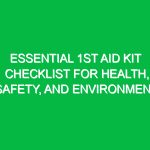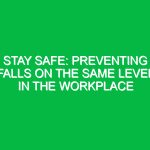Understanding 3-Point Ladder Contact in the HSE Context
In the realm of Workplace Safety, the term “3-point ladder contact” is critical. It refers to a Safety practice that ensures stability and minimizes the risk of falls when using a ladder. This method involves maintaining three points of contact with the ladder at all times—typically two hands and one foot, or two feet and one hand. This concept is particularly vital in the Health, Safety, and Environment (HSE) domain, as it significantly contributes to Injury Prevention and promotes a culture of Safety.
Ladders are ubiquitous in many work environments, from construction sites to warehouses. Yet, they also pose a considerable risk if proper Safety Measures are not followed. According to the Occupational Safety and Health Administration (OSHA), falls are among the leading causes of workplace injuries and fatalities. By understanding and implementing 3-point ladder contact, workers can greatly reduce these risks, creating a safer work environment for everyone.
The Importance of 3-Point Ladder Contact
Maintaining 3-point ladder contact is more than just a safety guideline; it’s a fundamental practice that can save lives. When workers ascend or descend ladders, they expose themselves to various Hazards, including slips, trips, and falls. The 3-point contact method ensures that a worker’s center of gravity is stabilized, providing better balance and control.
Real-life examples abound that illustrate the importance of this practice. For instance, a construction worker named John, who consistently adhered to 3-point ladder contact, avoided a potentially disastrous fall when his footing slipped. By maintaining two hands and one foot on the ladder while reaching for supplies, he was able to regain his balance and avoid injury. This anecdote highlights how simple adherence to safety protocols can make a significant difference.
Key Components of 3-Point Ladder Contact
To effectively implement 3-point ladder contact, workers should be aware of several key components:
- Proper Ladder Selection: Choosing the right ladder for the job is crucial. Ensure that the ladder is rated for the intended load and height.
- Correct Positioning: The ladder should be positioned on stable, level ground. For extension ladders, a 4:1 ratio of height to base distance is recommended for optimal angle.
- Safe Climbing Techniques: Always face the ladder while climbing, and maintain three points of contact. This means having two hands and one foot, or two feet and one hand on the ladder at all times.
1. Proper Ladder Selection
The foundation of Ladder Safety begins with selecting the appropriate ladder. Factors to consider include height, weight capacity, and material. For example, fiberglass ladders are excellent for electrical work because they are non-conductive. In contrast, aluminum ladders are lightweight and easy to transport but should be avoided near Electrical Hazards.
2. Correct Positioning
Positioning a ladder correctly is just as important as the ladder itself. The base of the ladder should be placed on firm, level ground, and the ladder should be angled properly. The recommended angle is a 4:1 ratio, meaning that for every four feet of ladder height, the base should be one foot away from the wall or vertical surface.
3. Safe Climbing Techniques
Once the ladder is selected and positioned, the climber must utilize safe climbing techniques. This includes keeping tools in a tool belt rather than carrying them while climbing, and always maintaining three points of contact. By following these guidelines, workers can ascend and descend ladders with confidence.
Potential Hazards and Risks
While 3-point ladder contact significantly mitigates risks, it’s essential to recognize potential hazards that can still lead to accidents. Common risks associated with ladder use include:
- Slippery Surfaces: Wet or oily surfaces can increase the chance of slipping.
- Overreaching: Leaning too far to one side can destabilize the ladder.
- Improper Ladder Use: Using a ladder for unintended purposes, such as standing on the top rung, can result in falls.
Each of these hazards can be managed through proper Training and awareness. For instance, training sessions emphasizing ladder safety can include practical demonstrations of 3-point ladder contact, helping workers understand its importance in real-world scenarios.
Best Practices for Implementing 3-Point Ladder Contact
To ensure that 3-point ladder contact is effectively implemented in the workplace, consider the following Best Practices:
- Regular Training: Conduct regular safety training that includes ladder safety and 3-point contact techniques.
- Conduct Inspections: Regularly inspect ladders for damage or wear and remove unsafe ladders from service.
- Encourage a Safety Culture: Foster an environment where workers feel comfortable reporting unsafe conditions or practices.
Regular Training
Training is paramount in reinforcing safe ladder practices. Regular workshops and safety meetings should emphasize the importance of 3-point ladder contact. These sessions can include hands-on training, where workers practice climbing ladders while adhering to the safety protocols.
Conduct Inspections
A proactive approach to ladder safety includes routine inspections. Before each use, workers should visually inspect ladders for any signs of damage, such as cracks or bent rungs. If a ladder is found to be unsafe, it should be tagged and removed from service immediately.
Encourage a Safety Culture
Creating a culture of safety is crucial for maintaining high safety Standards. Encourage employees to speak up about unsafe practices, and recognize those who consistently adhere to safety protocols. When workers feel valued and empowered to prioritize safety, the entire workplace Benefits.
Legal Regulations and Standards
In the pursuit of Workplace Safety, understanding the legal regulations surrounding ladder use is crucial. Various organizations set standards to ensure Safe Practices, including osha in the United States, which provides guidelines for ladder safety. OSHA mandates that employers train their employees on safe ladder use and ensure that ladders are maintained in proper working order.
In addition to OSHA regulations, employers may also need to comply with local or state regulations that may impose stricter guidelines. Familiarizing oneself with these regulations is essential for legal compliance and for promoting a safe workplace.
Conclusion
In summary, the practice of maintaining 3-point ladder contact is essential for promoting Workplace Safety. By understanding its importance, recognizing potential hazards, and implementing Best Practices, organizations can significantly reduce the risk of falls and injuries associated with ladder use.
As we navigate through various work environments, it is imperative to prioritize safety protocols like 3-point ladder contact. Not only does it protect workers, but it also fosters a culture of safety that can lead to greater productivity and morale. Every worker has a role to play in maintaining a safe workplace—let’s ensure that we all commit to safety practices that keep us secure and healthy.


